Community Issues
Community issues are identified via two primary approaches: the analysis performed by planning professionals as part of the study; and comments expressed by the citizenry through the various public engagement venues. What has been so encouraging about Huntsville’s effort thus far is how closely community input has mirrored issues identified by planners.
During the first year of outreach, citizens were highly engaged and involved in visioning for the future of the community. Based on the range and intensity of response, the citizens of Huntsville are deeply interested in shaping their own future.
The first step in shaping a community’s future is to identify the core issues and challenges that the community is facing currently, and those which may develop in the future, with an eye on developing strategies to address them. What follows is a collection of large-scale strategic issues – again, based both on professional review and public input – for consideration by the BIG Picture planning effort as it continues. Root causes and potential remedies are varied, and will continue to be subjects for discussion. In the meantime, these issues represent a baseline diagnosis that can inform our next steps.
Huntsville’s dominant development patterns reflect the era in which the region experienced some of its greatest growth: the 1950s and 60s. The low-density model that came into favor during the post-war decades is well-represented in and around the city – broad stretches of single-family subdivisions served by commercial strip corridors and thousands of miles of infrastructure. This land-intensive growth approach continued with only a few pauses into the 21st century, and the resulting annexation has created a city of over 214 square miles.
It is important to understand that this growth did not occur randomly. Market forces and the implementation of many community amenities drove Huntsville’s expansion: Eastern settlement was spurred by development around the Robert Trent Jones Course; southern growth followed the implementation of the Parkway, and access to Redstone Arsenal; activity in the northwest was generated by the success of Cummings Research Park; and southwestern development sought to fill in along I-565, and to support new industrial growth in Limestone County. The rapid expansion of Huntsville’s city limits happened for many reasons, but it is also important to recognize the challenges that that growth now represents.
Infrastructure Expense

Many of Huntsville’s neighborhoods were developed in the 1960s and ’70s, including this street in North Huntsville.
The challenge presented by this model is three-fold: increasing costs associated with infrastructure are requiring a tighter analysis of how a city supports growth, the blight associated with older strip centers can have negative impacts on the local economy, and shifts in the market and consumer demand are pushing communities toward new business models.
Rising infrastructure costs (both to install and maintain) paired with shrinking municipal budgets make it increasingly cost-ineffective to serve and support “greenfield” projects (new development on previously undeveloped parcels, generally those not yet served by infrastructure), particularly on the periphery of the incorporated service area.
When extending infrastructure, it takes lower-density development like strip centers or single-family subdivisions significantly longer to offer the tax return on investment to pay for that extension. For residential development, the cycle is often so long (20 years or more) that the municipality is committing maintenance funds before the initial construction costs have been recouped. While commercial development’s return is typically much faster (4-5 years), the impact is less direct: new centers may “cannibalize” existing retail nodes, reducing sales tax performance on the older sites.
Beyond immediate expenditures on things like roads and water/sewer, additional municipal services must be considered as a city’s footprint expands. For example, the Southwest subarea has not exhibited intense growth pressure, yet. As that area populates, it will exert pressure on planning to provide public safety infrastructure (fire, police, emergency management, for example), schooling, trash/recycling, parks and community centers, etc. As growth accelerates in the region, it will warrant additional fire stations, police stations, waste transfer stations, public works staging areas, and perhaps even a dedicated municipal center to serve the westernmost part of the City. These represent a significant capital outlay that should insist on a reasonable return.
Greyfields and Blight
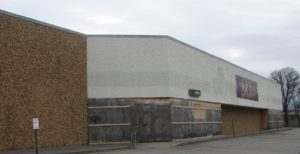
Greyfield Example #1: A vacant grocery store on North Parkway.
Underperforming and vacant commercial centers – often referred to as “greyfields” – are visible throughout the city, but particularly along the Parkway and on some of the older segments of corridors like University Drive. Rarely designed to last for more than a couple of decades, their decline is hastened when cheap land and wide thoroughfares make it easy for new strip centers to cannibalize old ones.
While competition is good for a healthy market, saturation can result in blighted corridors and declining performance in tax rolls. However, rather than attempt to artificially curtail the development of new centers, it is important to look at new and innovative strategies for redeveloping the greyfields… in most cases as something very different from when they were built.
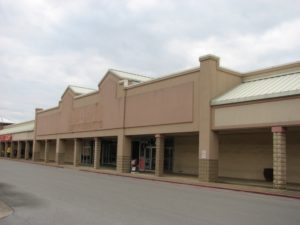
Greyfield Example #2: Haysland Square in Southeast Huntsville.
Large-scale, single-use zoning designations accommodate strip development well, but they do not encourage or support contemporary mixed-use development models ideal for many of the under-performing parcels. A lack of enforced design guidelines allow for practically-disposable development to be erected and then left behind when the “next new thing” pops up just down the road. Therefore, much of the responsibility for reversing commercial blight will lie on the City’s regulatory framework.
By updating zoning laws and enforcing a publicly-vetted level of design controls, the City could expand the potential pool of reinvestment options. This can improve the revenue performance of the acreage, upgrade the visual impact on the neighborhood, and – by taking advantage of proximity to existing infrastructure – reduce the dollar amount spent on support and service.
Changing Demographics… and a Changing Market
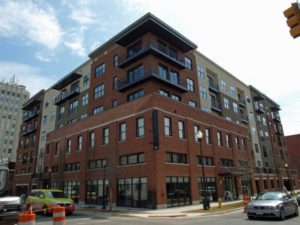
By the end of 2016, more than 600 apartments will have been built in Downtown since 2010– including the 75-unit Belk Hudson Lofts (pictured on the right). These developments appeal to both Millennials and Boomers.
The market for low-density models is shrinking. The changing demographics outlined earlier in this report are having an effect on demand. The two largest demographic cohorts in the United States are the “Boomers” and the “Millennials.” These two demographics have the population numbers to substantially shift buying patterns.
On a national scale, many boomers are – for a variety of reasons – divesting themselves of larger homes in favor of something that better suits their lifestyle. Loss of mobility is driving many of them to locate closer to the goods and services they seek, and a reduction in family size or a shift to retirement has a large number of the boomers looking for different housing options. Overall, boomers are rethinking the quality-of-life options in their community.
At the other end of the age spectrum, Millennials are establishing substantially different buying patterns than previous generations. Driven by a combination of changing priorities and unprecedented levels of student debt, they are buying big ticket items like cars and homes in declining numbers. Their financial realities have a profound impact on how they live, work and shop. Millennials are leading national trends of migration to revitalized urban cores and placemaking in smaller communities. Private sector development is beginning to respond to these changing market conditions.
We can already see these forces acting on regional and local levels. In the City of Huntsville, building permit and Certificate of Occupancy (“CO”, required by the City to inhabit a residence) approvals for single-family homes declined between 2012 and 2014. Permits and COs for multi-family dwellings, however, were up substantially during this same period.
Part of this is being driven by the fact that buildable land within the City limits is becoming increasingly scarce (for example, due to restrictions imposed by Slope Development Districts and floodplains, there are fewer than 1,000 acres of developable land remaining in the Hampton Cove area), but it also represents changes in consumer preference. While the convenience of “big box” stores will always be a draw, shoppers are also looking for something more – like neighborhood niche retail that speaks to the unique aspects of a particular part of the city. (Local examples include Five Points and Providence.) This is frequently expressed as an exercise in “placemaking”; that is, developing with an eye toward creating an experience, not just a product.
Placemaking in the Future

Construction continues on a new phase of homes in Providence, a “New Urbanist” neighborhood in Northwest Huntsville.
For Huntsville, multiple active and planned mixed-use projects indicate a market push toward investments in the core. The successes of Belk-Hudson Lofts and Twickenham Square have catalyzed new development on the old Holiday Inn site, and a vacant block on Jefferson and Holmes, as well as interest in several other parcels within the historic center.
Huntsville’s downtown is not alone in responding to market demands. Mixed-use “new urbanist” developments are on the ground in northwest Huntsville and the Jones Valley community. The placemaking represented by these new types of development are examples that indicate that mixed-use development is not something that can or should only happen in a stereotypical downtown. For a city the size of Huntsville, it is a scalable application that should be practiced on the neighborhood and subdivision levels as well.
To be clear, this is not a suggestion that single-family suburban developments will disappear. Home ownership is a keystone in the national and local economies, and single-family subdivisions will continue to be a desirable and viable choice. Likewise, auto-oriented commercial centers will continue to have a place in the retail landscape. But in order to position the City of Huntsville to respond to changing markets, changing demand, and changing population, the challenge will be to diversify our existing residential and commercial stock.
As noted in earlier chapters, the most intense period of Huntsville’s growth coincided with the wide-spread adoption of “sprawl”-oriented development patterns. Consequently, the city established a transportation network in response to this intense period of growth and the wide varieties of single-use developments. This network continues to serve the region very well – commute times are among the lowest of comparable metro areas – but as with re/development patterns, impending change will necessitate a long look at how we get around Huntsville in coming decades.
– The Shrinking Transportation Dollar

The City of Huntsville’s “Restore Our Roads” campaign logo.
There are multiple factors at play with regard to transportation planning and most important among them is the change in roadway financing. Available transportation dollars have become very limited within the past decade and, in recent years, declining State revenues and uncertain Federal funding have combined to squeeze municipalities for money to maintain, expand, and upgrade local networks. Huntsville’s own “Restore Our Roads” campaign is key evidence of that.
The “Restore Our Roads” campaign was a result of top priority regional projects being deferred by the Alabama Department of Transportation due to lack of available funding. The City raised its own taxes in order to make it more feasible for the State to engage the projects in a timely manner and, as a result of the campaign, Huntsville has dedicated $25 million per year towards improving critical transportation networks throughout the community. This is an unprecedented strategy, but until the fiscal climate changes on the State and Federal levels, local governments are going to bear more of the burden for the construction and maintenance of their own roads.
This underscores a point made in the discussion of the re/development issue. As funds for roads become more difficult to procure, communities will have to be more judicious in planning and constructing new roadways. Each new road constructed generates an additional expense in future infrastructure maintenance. This places a demand on communities that each roadway—new and existing—be used as efficiently as possible.
For Huntsville, this is particularly true. Not only are the short commuting times a selling point for business recruitment, but the role of the City as North Alabama’s regional employment center requires a high-functioning commuting roadway network. The importance of the health and viability of the transportation network cannot be overstated—particularly as the region continues to add workers and residents.
Solutions in Traffic Technology

Memorial Parkway at Max Luther Dr. A typical Parkway intersection with “service” and “main” (limited access) lanes.
Today, cities have choices beyond building new roads or adding more lanes. There are strategies that can supplement the standard approaches to adding capacity to the overall mobility network. Technological solutions for managing traffic congestion are improving rapidly, and innovative approaches to signalization and monitoring are helping municipalities get more capacity out of existing roadway infrastructure. With this new technology, like intelligent transportation systems (ITS), roads do not need to be designed for the “worst case scenario Signalization can be programmed to respond to the ebbs and flows of the daily commute, so that intersections function better, and cars move more consistently and steadily. By coordinating technology and construction/expansion, a city can get more bang for its paving buck.
Providing Options
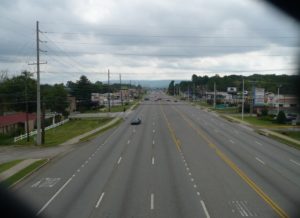
University Drive—One of Huntsville’s main arteries.
Another advantage of implementing high-tech solutions is that it becomes easier for roads to be designed and/or modified for more context-sensitive, and multi-modal, options. The vast majority of the current local network is designed to move cars – as it should be – but often without consideration of alternatives. In cases like Memorial Parkway and Interstate 565, the car is obviously the primary and only applicable mode. On most major surface high-volume corridors as well, automotive traffic must take priority.
However, as context scales down – that is, as it transitions from large-scale uses to smaller commercial and neighborhood settings – the streets that serve them should offer multi-modal options. Unfortunately, in Huntsville, they have often provided limited options.
The Five-Lane Section
Huntsville is well-served – and perhaps might be over-served – by a street design that has two travel lanes of traffic in one direction, a continuous center turn lane, and two more travel lanes in the opposite direction; a cross-section of five lanes. The lanes themselves are often generously wide, and they encourage speed. Drivers intuitively perceive the connection between lane width and speed. This design model is particularly good at moving cars through parts of a city. However, when they traverse neighborhoods, they serve more as an “edge” than a “seam”; that is, they divide neighborhoods rather than knit them together. It is a design that is uncomfortable to walk along, unsafe to bike, and at times very difficult to safely cross.
To some, this might not register as an issue. However, a significant concern noted both by planning staff and by public comment was the dearth of meaningful and effective bicycle and pedestrian infrastructure. Other discussions included how Huntsville has hundreds of miles of sidewalks, but the existing sidewalk network is fragmented and in too many cases “doesn’t go anywhere.”
The Case for Transportation Choice
It is important to keep one fact in mind: like other metropolitan areas, the car will continue to be the primary mode of transportation in the Huntsville metro area. To plan for any other expectation would be unrealistic and unfeasible. However, it would also be unrealistic not to plan for more transportation diversity in growing the network, precisely because of anticipated increases in population and demand.
There are a wide variety of reasons for diversifying connectivity in a community; foremost among them is in response to market forces. As discussed in earlier sections, the largest demographic cohorts – the Boomers and the Millennials – are leading a shift in what a community wants and needs from its transportation infrastructure.
From the perspective of the Boomers, as they age into retirement – and live well into it – many of their generation are becoming less comfortable with frequent and/or extended driving. Though some might give up driving altogether, many are looking for opportunities to simply drive less. If they’re provided opportunities to get around without driving – not exclusively, but for shorter or less imperative trips – they’re taking advantage of these opportunities. Developing a multi-modal network serves the health and safety of Boomers, as well as social well-being: making it easier for individuals to stay in their homes and in their neighborhoods as they age.
For Millennials, the attraction to a diverse network comes from several places. One motivation is part of a broader demographic trend away from sprawl-based development. This up-and-coming generation has been buying homes in smaller numbers than previous generations. They express high levels of support for alternative modes of travel — from bike and pedestrian accommodations to transit and newer alternatives like ride-sharing and car-sharing services.
Another motivation is financial constraint. Millennials are being hit twice– by coming out of college with more debt than any previous generation, and coming into a job market that is among the worst in half a century. As a result, many younger citizens have been deferring large-scale purchases – such as houses and cars – and looking for lower-cost alternatives. More so than predecessors, they have been looking for (and choosing) communities that offer those alternatives, be it transit, bike/pedestrian, some iteration of the “sharing economy“, or a combination thereof.
An additional consideration, less pronounced but still apparent, is the extent to which this group is attuned to environmental concerns. Multiple polls and studies find Millennials to have more interest than prior generations in sustainability issues, and they are expressing those ideals in their purchasing habits.
Increasing Capacity by Decreasing Demand
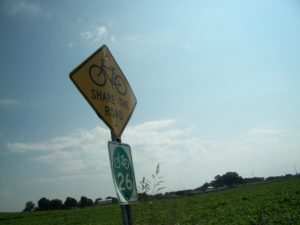
A “Share the Road” sign in Limestone County.
Market forces aside, another benefit of transportation choice is that it can help maintain the performance of the car network. Though it might be some time before there is a statistically significant number of bike commuters, traffic performance can be improved greatly even by eliminating some of the small local trips that add unnecessary volume to the street network. When residents have no choice but to make a vehicle trip, it adds strain to the roadway network and increases drive times for those who actually do have to drive among destinations.
Health and Transportation Design
Positive health outcomes are among the benefits of a diversified transportation system. Though the modes may continue to be dominated by the auto, simply providing more opportunities to walk and bicycle can have marked effects on public health. In a state that struggles with obesity (and childhood obesity in particular), integrating more physical activity into transportation can improve the physical well-being of residents.
This is felt in particular at either end of the age spectrum. Among the elderly, access to safe and comfortable walking infrastructure has been shown to improve and extend the quality of life of senior residents. Among our youth, there is more exercise – and more freedom – when parents feel comfortable letting their children walk or bike to a friend’s house, or to a store, or to school. Though these instances might seem highly localized, their cumulative effect on the well-being of residents of all ages is worthy of consideration.
Another consideration of how a mobility network is built has to do with the working-class and the challenges for lower income households. Recently, the United Way of Madison County completed their “Community Needs Assessment”, an analysis of the issues facing the most vulnerable segments of our population. ‘Access to Transportation’ was consistently rated the highest, or among the highest, by those surveyed in terms of stressors. More than food, more than rent, more than child care, the ability to get around town – to get their children to school, to get to and from employment, to access goods and services – was cited as one of the biggest challenges faced by lower-income residents.
Even more striking was that when reviewing the ranking of concerns from the perspective of the service providers or other local stakeholders, transportation was not as highly ranked. This illustrates the fact that the need may be much greater than a surface analysis would indicate. To that end, providing a more varied mobility network would help reduce the pressure on families who might have limited resources for getting where they need to go.
But What About Transit?

A Shuttle bus in Downtown Huntsville.
Throughout Huntsville’s BIG Picture process, this question was brought up in repeated venues and formats. People of all ages and backgrounds asked about if and how we could expand our current transit operations. Huntsville’s current transit system consists of fixed-route Shuttle bus routes and the demand-response Handi-Ride paratransit service. Ridership has increased significantly in the last half-decade– –but even with this growth less than 2% of the city’s population uses transit on a daily basis. One important item to note up front: Current transit operations in Huntsville, like many cities, is constrained by one primary concern – funding. If the community agrees that Huntsville should have a broader transit network, then funding considerations must be kept at the forefront of any large-scale transportation discussion.
Cost scales up by capacity, of course. Fixed-route bus service is among the most cost-effective transit modes, but it doesn’t have nearly the carrying capacity (or return on investment—for example, transit-oriented development) that larger modes would. There are several options ranging from streetcars, to Bus Rapid Transit (BRT), to light rail, and heavy commuter rail. Naturally, these options increase greatly in cost, to the point that most networks require significant investment from the federal level, particularly for start-up or expansion. The challenge is that, much like road funding, federal funding for transit has also been shrinking. Indeed, the bulk of recent expenditures have gone to maintaining or expanding existing networks in large metro areas. Funds for new and innovative systems in mid-sized cities have been much harder to come by, and uncertainty on the federal level makes it very difficult for local transportation organizations to plan for transit. To make matters worse, the Alabama state constitution bars transportation tax revenues from being spent on anything but roads and bridges.
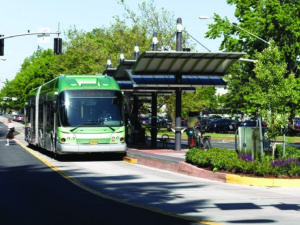
Eugene, Oregon has successfully implemented BRT in a metro area roughly Huntsville’s size. Photo credit: Maryland Transit Administration
Recognizing that transit funding is scarce, but demand exists (and is increasing), it is likewise important to study what type or types of transit might make sense for Huntsville. Rail has been a popular request, but is among the most cost-prohibitive. Buses are much less expensive to purchase and implement, but they don’t have the support among a broad constituency that would make them a feasible option. Mid-range options like BRT might offer a good compromise, but they’re still costly, they have certain demands on rights-of-way, and they might also require some level of public buy-in. Regardless, some balance must be found between cost and anticipated ridership for the citizens of Huntsville.
The other side of the coin with transit is land use. Huntsville’s varying topography (mountains) and man-made barriers (i.e -Redstone Arsenal) have a lead to a very spread-out development pattern, making it a challenge to implement additional, higher-capacity transit in the city. In order to make buses or trains financially feasible to implement and operate, there must be sufficient ridership, and that ridership must have areas of concentration. This is often referred to as “transit-supportive density”, and there are very few areas in Huntsville that would fit that description. Picking up one or two riders per stop means that in order to stay feasible, the mode must make many more stops. However, in doing so, the cost-efficiency and gain of ridership of a transit system is reduced. There must be fewer stops with more people, if heavier transit like BRT or light rail is to make sense.
With these constraints in mind, if the community does wish to have greater access to public transit, the city needs not only to plan for the network, we need to change the physical way in which our city is being built. Creating and supporting areas of higher density – not necessarily everywhere, but in targeted areas agreed upon by the community – will offer the concentration of ridership that can make public transit more feasible. The seeds of that vision can be seen in Downtown, but there isn’t much in the way of development outside of the core that would qualify.
Interestingly, there are some technological innovations that are helping to lower the threshold of what must be in place for transit to work. Currently, in order to get “choice” riders (those who do not have to ride transit, but choose to) to participate in sufficient numbers, a service must offer frequent trips and limited wait times. That will require a lot of extra buses or train cars, and a lot of extra drivers and maintenance, merely to keep the wait times down; and there’s no guarantee that any of the vehicles would be used to capacity. This is a very cost-inefficient approach to attracting ridership.

The Huntsville-Madison County Railroad line in Southeast Huntsville. Currently a little-used freight line, its location makes it a potential corridor for high-capacity transit.
Continued advances in both system technology and personal technology may offer ways to serve more riders with less investment. Technology can help identify peaks in ridership and reduce headways to suit. In terms of personal technology, apps already allow individuals to accurately track the schedule and progress of public transit– minimizing wait times and allowing personalized route planning. Having handheld access to transit information will be important to support it.
From the broadest perspective, with all the challenges and opportunities facing transportation in Huntsville, the key will be to put a plan in place. Particularly in terms of traditionally underserved modes like bicycles, pedestrians, and transit, laying out a community-supported vision is the first step in achieving better implementation.
Even if the community doesn’t see, for instance, a new BRT network for another ten years, the time to begin planning for it, studying its viability, and identifying supportive land use strategies is now.
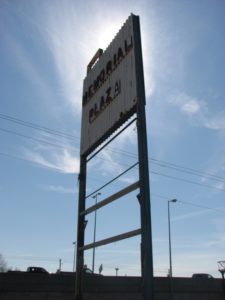
A deteriorating shopping center sign on North Parkway.
One of the most common refrains during the BIG Picture process has been the fear of disinvestment in existing neighborhoods. This fear has not been limited only to older areas, nor to traditionally disadvantaged neighborhoods, but has represented a concern for many parts of our community. This concern is not misplaced. Empty or underutilized commercial centers, vacant office complexes, empty parking lots, poorly-maintained housing – all are symptoms of disinvestment, and examples of such (in varying scales) can be seen in different and varied parts of Huntsville. To understand the concern, it is important to understand the causes. Except in extreme cases (the closing of a regional employer, the relocation of a key industry, the occurrence of a natural disaster, etc.), disinvestment is usually a slow, decades-long process that has many roots. As housing stock ages, new housing is built in other parts of a community, which can draw off residents looking for something new. As the residents themselves age, if there is not a diverse housing stock that would allow them to stay in a neighborhood, they may relocate to a part of town that offers housing more appropriate to the next stage of life. If they do not move, and young families don’t have the opportunity to backfill into a neighborhood, local schools may suffer– a condition that is both a symptom and catalyst of disinvestment. As commercial developments age and are replaced with new centers further down the road, this can result in a slow bleed of desirable shopping and services, leaving behind blighted strip malls. If civic amenities are not maintained or expanded, there is little incentive for current or new residents to reinvest in their homes. These are among the most common causes of disinvestment in a community.
However, it is important to recognize that some level of disinvestment occurs in all neighborhoods. It is merely a cycle of growth and change. The challenges are in how we deal with disinvestment, how its effects can be mitigated, how its duration can be shortened, and how its impacts can be reversed.
How to stem – and reverse – the tide
Because there is a wide range of causes and symptoms, there is also a broad array of responses depending on the specific community – some areas might have an overabundance of greyfields; others might have blighted housing stock in excess.
Here is a list of some of the ways disinvestment can be addressed:
Community partnerships.

Downtown Huntsville, Inc. logo
This is the least resource-intensive, but can often be the most difficult. To get a neighborhood moving in a direction, all stakeholders need to be pulling in that same direction. In some struggling communities, this can be thwarted by a lack of communication or coordination among individuals and organizations; political infighting; a lack of shared vision; uncertainty about empowerment or responsibility; or conflicting interests among disparate stakeholders. A community must respond to disinvestment, and look for partnerships within and beyond their boundaries.
Foremost among these is the creation of an “Improvement District” or a “Business Association”. There are many advantages to forming an area-specific entity, including the building of consensus among individuals and organizations that have a shared interest in the area; the ability to craft a defined plan for reinvestment and growth; and the creation of a point-of-contact for coordination with the City and potential outside investors. In particular, the organization can focus on promoting the area. As our culture has become more media-savvy and digitally-immersed, the messaging around a particular community is very important. Community partnerships can help share the good word about the positive aspects of a neighborhood, while simultaneously working with local authorities to address the challenges.
Coordinated vision.
Related to the point above, for any traveler to get where they want to go, they have to have a map. When dealing with disinvestment, that map is a vision plan for what the residents and business owners want their community to look like, and how they plan to achieve that future vision. While the plan may be facilitated by the City, it must be led by the community. No municipality can create a successful plan for a neighborhood; it must be created in partnership with the neighborhood.
The vision should include a variety of elements, such as talking points for “selling” the community to investors; target areas for municipal investment or demolition; community engagement strategies for developing support within the district; road and streetscape improvement projects; changes to land use; hot spots for redevelopment and problem areas that need specific action, including public safety assistance; and financial strategies for supporting development, among many others. Most importantly, the vision creates a single direction toward which the entire neighborhood can work.
Targeted blight strategies.
Huntsville is no exception when it comes to blighted areas. A popular refrain from many of the Big Picture outreach meetings was “The City just needs to buy [name that building] and tear it down”. Demolition is, in fact, a viable approach, but given financial constraints and the rights of property owners, it can and should only be used in extreme and strategic instances.
For some neighborhoods, the vision planning process might identify some catalytic sites; that is, those that if redeveloped would have a broad impact on reinvestment in the area around them. Depending on ownership and potential acquisition costs, that site could be cleared and then leveraged into future development of a scale and type more suitable for the neighborhood.
There are some obvious caveats with this tool. For one, it can be very expensive. No city, and that includes Huntsville, could afford to buy and demolish all of its blighted properties. It’s simply not financially feasible. Secondly, profligate demolition can set a bad precedent. Some owners might simply allow their properties to slide into decline if they know that at some point the City will come along and bail them out. Lastly, a respect for property rights. Not everyone may agree on what constitutes an unattractive or underperforming property, and it is a similarly bad precedent for any municipality to exercise an overly-heavy hand in terms of acquisition. Used judiciously it is effective, but it cannot be the primary tool in the redevelopment toolbox.
Amenities.
Creating amenities in an area can be an effective tool for fighting disinvestment, both in commercial and residential sections of the district. While a consensus plan and clear messaging are important, the existence of some sort of amenities plays a part in encouraging new investment into a community. Parks, greenways, attractive public schools, cultural centers, community facilities, bike lanes, transit access – these are among the roster of amenities that can create enough “buzz” to bring people back to an area. These can be the function of municipal investment, public/private partnerships, and/or non-profit efforts, but regardless of how they originate, they are a large motivator of reinvestment in homes and businesses.
Placemaking.
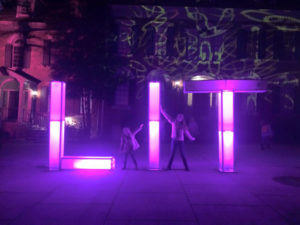
Downtown Huntsville, Inc. sponsors near-weekly free events in the city center, including an annual light show on the Courthouse Square. Photo credit: artshuntsville.org
Related to the provision of amenities is an effort known as “Placemaking”. Referenced briefly under Issue #1, placemaking is the process of creating or enhancing the unique character of a neighborhood or district. To be most effective, placemaking should consider both the public and private realms and the interactions between them. Put most simply, placemaking seeks to take the physical and cultural aspects that are unique to a particular neighborhood or district and use them to build and shape a sense of community. A strong sense of community is a pillar of neighborhoods that are safe, desirable, and sustainable – that is, communities to which reinvestment would be attracted.
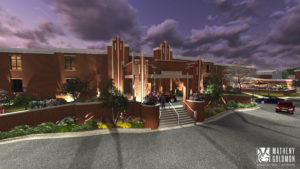
An architect’s rendering of the new Campus No. 805 development, which will be built on the site of the former Stone Middle School. Photo credit: Matheny Goldmon Architects
Downtown Huntsville – led by Downtown Huntsville, Inc. – has been actively pursuing this strategy, with well-publicized, positive results. It should be understood that all neighborhoods around the city, regardless of age or scale, can pursue a similar approach. Opportunities for creating a more localized sense of community identity are available throughout Huntsville, potentially developing as small neighborhood-based nodes that are each unique unto themselves, but are still a contributing piece to the identity of Huntsville overall.
Reversing disinvestment can be a long process. If a neighborhood slides into blight over the course of several decades, it is going to take a few years to pull it back out. Participants should also understand that there is no “magic bullet”; the demolition of one development, or the construction of an overpass, or the addition of a grocery store… none of these on their own will revitalize a neighborhood. But when taken as pieces of a broader effort, a community-supported strategy, a neighborhood can pull itself up out of decline and get back on the road to economic health and community vitality.
It is rare to plan for any community wherein the population suggests they have more than enough parks, or ball fields, or trails, or museums, and so on. During the first phase of public dialogue, Huntsville proved to be no exception. In multiple venues, citizens communicated a desire for more investment in “quality of life” (QOL) improvements. Among the specifics cited most often were John Hunt Park, the Greenway network, Ditto Landing, athletic fields in general, and support for the Arts. QOL is likewise not limited to public-sector investments. It also encompasses access to quality retail, health care, goods and services, and other amenities that are typically provided by the private sector, but which can be reached through public-private partnerships.
From a broader perspective, there is increasing appreciation that QOL investment isn’t just about making a city more enjoyable for its residents. It also overlaps with many of the other key issues on this list: It has a place in the balance between development and redevelopment; it is a key component in placemaking; it is an essential element in reversing neighborhood disinvestment; and is increasingly vital to regional economic development and workforce recruiting efforts.
In expanding and accelerating implementation of QOL offerings, there are some basic, but not insurmountable, challenges. Not least among these is funding. John Hunt Park alone is a multi-million dollar build-out, likely to occur over a decade. The paved greenways cost roughly a million dollars per mile to implement. With approximately 150 miles left to be installed, the balance required is daunting. On top of those two large ticket items are the myriad small parks, sidewalk improvements, riverfront projects, public art installations, and cultural amenities that all also need funding. Likewise, the expanding Huntsville community has expressed a strong desire for additional shopping and dining options, which require some level of creative thinking when shaping potential partnerships. Taken as a whole, it might seem completely impractical.
However, there are incremental approaches that can be used. For example:
The Arts Council has recently completed a Public Arts Master Plan. It provides an excellent strategic guide for adding public art as a matter of policy and practice, not merely as an addendum. It also makes several practical suggestions, such as setting aside a small percentage of any large municipal public works project budget (such as waterway improvements, roadway extensions, or sidewalk construction) for public art. This is already being piloted at The Avenue project Downtown, but can have application throughout the City. Philosophically, it takes the approach that an arts component is as valuable as a drainage system, and is equally valuable to any publicly-initiated project. By adopting this approach, the City can take a sizeable step in expanding Huntsville’s arts footprint as a part of our QOL.
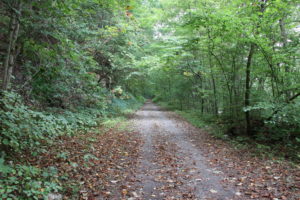
An example of a gravel bike path in Virginia. Photo credit: flickr/gammaman
The implementation of the greenway networks has been successful thus far, but in terms of the overall number of miles constructed, the rate of new greenway implementation has slowed due to construction costs. The City typically builds them out to a very high standard of finish: concrete, curbed, and piped. This is for good reason – long-term durability and low maintenance, in particular – but it slows the expansion of the network to a relative crawl.
There will be opportunities going forward to look at more incremental build-out approaches. For instance, rather than full construction on a given segment, a first phase might simply clear the path and pave it with gravel or some other temporary surface. While this is not an ideal approach for all users, it would at the very least get activity on the new route – the focus being simply getting people on the new trail. Then, as usage demands and as funds become available, segments could receive the full build-out. Another advantage to this approach is that it would make it easier to solicit private funding partners if they can actually see the segment cleared and in use. It becomes much easier to visualize the results of the investment.
One approach that could assist with implementation is petitioning private and/or non-profit partners to assist with planning, prioritization, and fundraising. In other cities, having a partner organization meant that someone was taking on greenway concerns full-time. In Chattanooga, the City formed an agreement with the Trust for Public Land, wherein the latter took charge of advocating/fundraising for the network. In Atlanta, their ground-breaking greenway project has been advanced in partnership with Atlanta BeltLine Inc., a non-profit that has lead the outreach and planning for their the BeltLine effort. The City of Huntsville is not equipped to advocate and fundraise for greenway construction to the extent that it would noticeably accelerate implementation. Linking with an organization like The Land Trust of North Alabama would allow the City to provide capital and construction support to an organization that would lead the engagement and implementation.
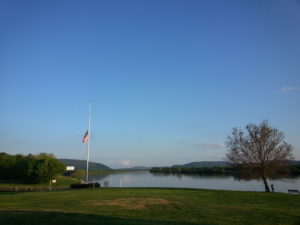
Looking East along the Tennessee River from Ditto Landing.
Master planning for Ditto Landing is an example of an incremental implementation that has already found some initiative. A great deal of public interest was expressed regarding the riverfront, and the Marina Board was amenable to conducting a master planning exercise for their property and the adjacent City land. Upon conducting a Citizens Academy and an online survey, the City of Huntsville, Madison County and the Ditto Landing Board developed a phased master plan to allow for the step-by-step addition of a recreational program to the facility. Much of this was targeted for public/private partnerships, and indeed the first step out of the ground was a private contractor entering into an agreement with the Marina board to provide non-motorized watercraft rentals. It is anticipated that these sorts of agreements could become the norm for the Marina, and would help accelerate a more complete improvement of the riverfront.
The City of Huntsville’s Department of Urban Development continues to aggressively court new retailers to the North Alabama market. Companies like Whole Foods, Cabela’s, and @Home have proven that Huntsville can attract and support national brands. In parallel, the City should concurrently work to support local and small businesses and start-ups. These types of employers make up the majority of retailers in Huntsville, and are engines for innovation. The City should continue its efforts toward streamlining small-business implementation, and actively support the development of incubators that can create companies and experiences that could be unique to Huntsville. If the community is vocal in its demand and flexible in its accommodations, Huntsville should be able to attract even more of the desired retail services to the city.
Recognizing that QOL improvements are not only popular with the community, but also valuable to continued economic development efforts and regional competitiveness, their timely implementation should be a priority.
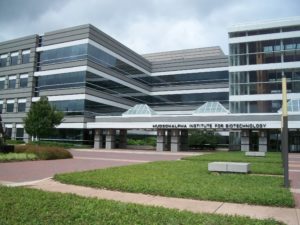
Hudson-Alpha Institute for Biotechnology in Research Park West.
Huntsville has historically maintained a resilient economy, particularly since the establishment of Redstone Arsenal. Today, Redstone and Cummings Research Park are the key regional employment centers and are strategic national resources. However, as a recent brush with sequestration illustrated, it is wise to continue efforts toward the diversification of Huntsville’s economy.
Over the years, Huntsville has been successful in adding industry that is not necessarily related to Redstone’s operations. The Hudson-Alpha Institute for Biotechnology has developed into a national presence in the biotech sector, and has helped Huntsville become a growing biotech hub. Curse Gaming relocated their headquarters from San Francisco, and may be the first of many high-tech businesses to create a presence in the Tennessee Valley. Companies like Toyota, Endo Pharmaceuticals, PPG, CINRAM, and others have allowed Huntsville to showcase the advanced manufacturing abilities of the region’s workforce. As a result, recent new industrial additions like Remington and Polaris have represented not only a very different sector, but they have also reinforced an alternative brand: that of Huntsville as a recreation destination. New job creation in the sectors of recreation, healthcare, high-tech, biotech, education, automotive, advanced manufacturing… the metro economy is broadening its focus across many disciplines.
Even the programming on the Arsenal itself has diversified. Originally a “missiles and space”-oriented facility, Redstone now counts among its tenants the Army Material Command, Army Space and Missile Defense, Department of Defense organizations (including the Missile Defense Agency), NASA’s Marshall Space Flight Center, the Terrorist Explosive Devices Analytical Center, and Department of Justice organizations (including the ATF’s National Center for Explosives Training and Research, and the FBI’s Hazardous Devices School). The Team Redstone Guidebook suggests that due to this broad array of distinct organizations and functions, the facility is often described as a “federal office park.”
Diversification is obviously the watchword for a healthy and sustainable economy, but there are a number of approaches to growing a diverse economy. While Huntsville has excelled at attracting a wide range of industries, what it has thus far not done as well is create a nurturing environment for smaller companies and start-ups in emerging business sectors. Small businesses make up a large part of the nation’s economy, and are disproportionate generators of innovation. They need not only support for success, but also an environment that allows them to fail. The ability to crater, and to get back up again, is crucial to a healthy innovation environment – von Braun himself had no shortage of failures while developing the space program. This can attract the creative minds and talent needed to reinforce Huntsville’s position as an innovation hub.
Another concern that was discussed frequently was the impact of digital infrastructure on economic growth. After watching regional counterpart Chattanooga develop city-wide gigabit Internet service, public interest was very strong in Huntsville for putting a similar network in the ground. For many, the idea of high-speed Internet service is no longer seen as an amenity, but rather as a basic requirement. In a high-tech city like Huntsville, it is seen by some stakeholders as a necessity. In response, the City and Huntsville Utilities have reached out to private sector partners that want to help with the implementation of a city-wide network. Getting that “new infrastructure” successfully installed will be an important goal in attracting both businesses and workers to the region.
The New Workforce
Speaking of workers, the flip-side of the economic coin is maintaining and attracting a workforce that can support and thrive in Huntsville’s unique and vibrant economy. These new workers – particularly the more mobile and flexible Millennials – don’t just look for employment; they look for lifestyle. Often to them, the quality of life in a city is just as important as the securing of employment. Recognizing that, it is important for Huntsville to look at economic development beyond traditional incentives and toward investment in amenities and the public realm.
One approach is to take advantage of our existing regional strengths. As evidenced by the Remington and Polaris moves, the Tennessee Valley has a growing reputation as a recreation mecca. It would be “low-hanging fruit” to diversify Huntsville’s brand by supporting and expanding programs that highlight the local recreation culture. Specific areas of opportunity include:
- The expansion of the existing greenway network;
- The enhancement of the Tennessee riverfront;
- Improved connectivity to surrounding parks;
- Growth of Land Trust of North Alabama holdings;
- The build-out of the “riverwalk” network through Downtown;
- The construction of John Hunt Park;
- And the development of a “Huntsville Outdoors” website, among others.
The elements of the recreation brand are already in place, they merely require investment, refinement and messaging.
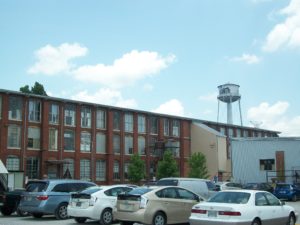
Lowe Mill has an eclectic mix of studios, shops, and restaurants.
A strong workforce does not rely solely on the import of talent. It also leans heavily on the development of local workers, and the foundation for this is education. The fact that North Alabama has, in the past 30 months, been able to attract over 10,000 new jobs with companies like Remington, Polaris, and Google is a testament to the strength of our local educational infrastructure, as well as a call to ensure that this infrastructure works to stay ahead of the curve.
The innovative and rigorous school systems in the City of Huntsville, Madison County, and Madison City serve not only to attract families looking for high-quality public education; they also demonstrate to employers that the region will be able to continue to supply the kinds of high-quality, high-skill employees that businesses need to thrive. By the same token, there is a diverse roster of higher education offered locally by Alabama A&M University, the University of Alabama at Huntsville, Oakwood University, Drake State Technical College, and Calhoun Community College. This wide range of quality post-secondary options can provide well-educated workers for a variety of industries, making Huntsville even more attractive to the full spectrum of industries that do, or would like to, call Huntsville home. It should be a priority to constantly maintain and improve the local educational environment, ensuring that it continues to be a visible and positive economic attribute.
Another local strength is the strong “maker” culture that exists in Huntsville. From engineering and technology to the arts and brewing, the region is building upon a reputation for craftsmanship. This is the sort of authenticity that can help make a name for a community on the national stage, and it is not something that would have to be built from scratch.
The redevelopment of Lowe Mill as an arts center has provided a “center of gravity” for the creative community. Lowe Mill has morphed into a home not only for traditional artists, but also for printmakers, educators, culinary artists, architects, distillers, archaeologists, and musicians, among others. The pending redevelopment of the old Stone Middle School site as a “beer garden” anchored by two local brewing companies should have a similar impact, forming another node for the creative class. Related to the brewing culture is a growing culinary scene. Sparked in no small part by a rapidly expanding food truck culture, Huntsville can form its own identity as a “food hub”. Whether that is through support for food service incubators, or via an introduction of new dining ideas in new private commercial developments, or by increased engagement with local culinary programs like the one offered at Drake State, Huntsville can look to its neighbors – Chattanooga, Birmingham, and Nashville in particular – to see the benefits of a strong food identity.
Developing these nodes reinforces the placemaking strategy referenced in earlier points. This placemaking approach is a pattern that has been building for well over a decade. Some existing examples include Lowe and Lincoln Mills, Merrimack Hall, Downtown Huntsville, and the Historic Five Points district, but the approach could be applicable throughout the City. Numerous other sites – the Bailey Cove Grissom campus, Ditto Landing, the Meridian corridor through Alabama A&M, the Holmes corridor through UAH and Cummings Research Park, the 431 corridor through Hampton Cove – come to mind when thinking of future opportunities for creating unique local nodes and districts that enhance the quality of life of those who live there, and attract others to want to do the same.
Last modified: September 14th, 2018 at 12:28 am

